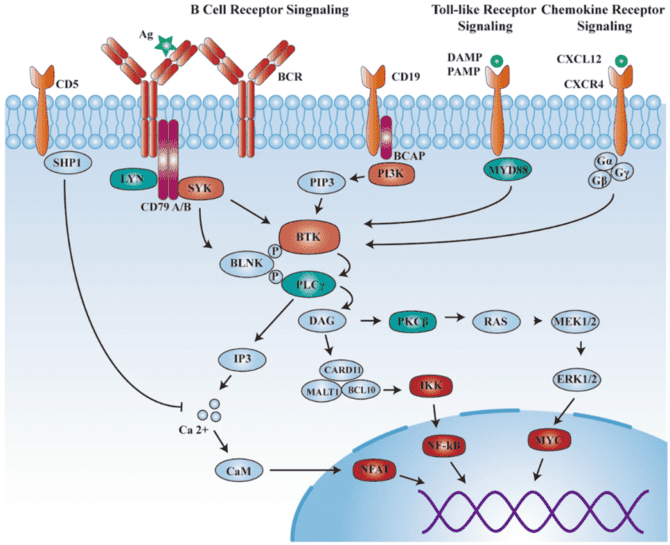As a CRO that has been deeply involved in the field of PROTAC for over a decade, BOC Sciences provides customized PROTAC design services for various targets. Bruton’s tyrosine kinase (BTK) is an essential target for PROTAC molecules against multiple diseases. With extensive expertise and comprehensive platform, we provide drug development services for PROTAC molecules to target BTK.
Introduction of BTK
Bruton’s tyrosine kinase (BTK), a member of the Tec family of nonreceptor tyrosine kinases, promotes B-cell growth, maturation, migration, and apoptosis. In addition, BTK signaling is involved in innate immune responses and regulates the production of proinflammatory cytokines. Cancer, autoimmunity, or inflammation may be a result of dysregulated BTK pathways. Studies have verified BTK as an essential target for agents against chronic lymphocytic leukemia (CLL).
BTK is primarily expressed in most hematopoietic cells such as B cells, mast cells, and macrophages, with the exception of T cells and terminally differentiated plasma cells. BTK is localized in bone marrow, spleen, and lymph node tissue. BTK is involved in the signaling pathway of low-affinity activating-Fcγ receptors for the immunoglobulin G (IgG)-containing immune complexes in monocytic cells. The Fcγ receptor signaling is present in mast cells and basophils that trigger the expression of pro-inflammatory cytokines, chemokines, and cell adhesion molecules.
 Fig 1. BTK in BCR signalling, TCR signalling, and chemokine receptor signalling pathway.
Fig 1. BTK in BCR signalling, TCR signalling, and chemokine receptor signalling pathway.
BTK PROTAC
Proteolysis targeting chimeras (PROTACs) are heterobifunctional molecules with three chemical elements: a ligand binding to a target protein (in this case BTK), a ligand binding to E3 ubiquitin ligase, and a linker for conjugating these two ligands. BTK PROTAC degrades the BTK through the ubiquitin-proteasome system. Different from the competitive- and occupancy-driven process of BTK inhibitors, BTK PROTACs are catalytic in their mode of action, which can promote target protein degradation at low exposures. BTK PROTACs have the potential to degrade BTK and regulate the related signaling pathways, which cannot be achieved by traditional inhibitors.
Current PROTACs Targeting for BTK
Since the first PROTAC was reported in the literature, the technology has moved from academia to industry. Currently, several PROTAC programs entering the early clinical development have been disclosed, such as NX-2127 and NX-5948, both of which are small molecule PROTACs containing CRBN-binding ligand and BTK-binding ligand. These two PROTACs are capable of targeting BTK for the indication of B-cell malignancies or autoimmune diseases.
Because the exploration of PROTAC as a therapeutic modality is in its early stages, there are still numbers of BTK PROTACs in preclinical or academic research stages. For example, TL12-186, a PROTAC targeting CRBN, considerably downregulated the expressions of 14 identified proteins, including BTK in MOLM-14 cells, by at least 25%; MT802, a CRBN-based PROTAC, effectively degraded BTK in cells with few off-target kinase binding. However, experimental evidence suggests that MT802 is not suitable for further in vivo studies; SFJ620, discovered by the modification on the CRBN ligand of MT802, retains potent degradation of BTK in cellular assays and has a superior pharmacokinetic profile to MT802 in mice.
Our Services of BTK PROTAC Development
- Library of heterobifunctional ligands are prepared in which BTK binding ligands are joined to E3 binding ligand by linkers.
- Synthesis of BTK PROTAC by assembling a BTK ligands, a linker and an E3 ligands to meet the individual requirements of customers.
- Optimization of PROTAC efficacy by building PROTAC library of varied linker lengths or different ligands.
- Binary binding affinities assay of PROTACs to BTK and E3 ligase by using surface plasmon resonance (SPR).
- Efficacy of PROTAC for depletion of BTK levels as assessed by Western blot and other evaluation methods.
Related Products
| BTK-PROTAC | CAS Number | Efficacy | E3 ligase-ligand | Structure | |
|---|
| MT-802 | 2231744-29-7 | >99% degradation at nanomolar concentrations | CRBN-thalidomide | 
| Inquiry |
| TL 12-186 | 2250025-88-6 | >90% inhibition of 193 kinases (including BTK) at a tested level of 1 μM | CRBN-thalidomide | 
| Inquiry |
Our Advantages
- One-stop services of BTK-PROTAC design
- Design and selection of small molecule ligands
- Expertise and experienced scientific team
- Data analysis, detailed results reporting and discussion
- Cost-effective and high-quality products
Project Workflow

References
- Jaime-Figueroa, S., Buhimschi, A. D., Toure, M., Hines, J., and Crews C. M., Design, Synthesis and Biological Evaluation of Proteolysis Targeting Chimeras (PROTACs) as a BTK Degraders with Improved Pharmacokinetic Properties, Bioorg Med Chem Lett., 2020, 30(3): 126877.
- Wen, T., et al., Inhibitors targeting Bruton’s tyrosine kinase in cancers: drug development advances, Leukemia, 2021, 35, 312-332.

 Fig 1. BTK in BCR signalling, TCR signalling, and chemokine receptor signalling pathway.
Fig 1. BTK in BCR signalling, TCR signalling, and chemokine receptor signalling pathway.



